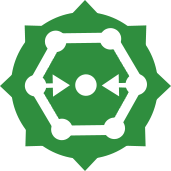 Poly-Build Tool
Poly-Build Tool Poly-Build Tool
Poly-Build ToolThe PolyBuild tool takes a group of spatial point objects and draws a polygon or polyline in a specific sort order to represent that group of points.
The most common use of this tool would be to create a Convex Hull polygon representation for a set of points. See the ConvexHull_TradeArea.yxmd from the Spatial Samples directory.
This tool can also be used for spatial layer development. A typical example where you would use this tool is if you had a collection of GPS data that you needed to translate into polygon or polyline objects. If you were mapping out a river, road, pipeline, reservoir or property boundary, for instance, this tool would be quite useful.
Select the Build Method. Choices include:
Convex Hull: The Convex Hull polygon is the smallest convex polygon that can be drawn to include a set of points. The polygon will not contain any concave angles, so it will never turn in on itself.
Sequence Polygon: The polygon will be drawn based on all the points within their sequential order.
Sequence Polyline: The polyline will be drawn based on all the points within their sequential order.
Depending on the Build mode chosen, the user will have to populate a series of drop down lists with the appropriate field name with respect to their data stream.
Select the Source Field from the drop down list. These are the points the tool is using to create the polygon object.
Select the Group Field from the drop down list. The group field should be the field that represents the poly object, so all the records that fall into the group will make up one poly object.
Select the Sequence Field from the drop down list. The sequence field is what the tool uses to draw the poly object. It sorts the records based on the sequence field and uses that order to draw the poly object.
Polyline: A polyline contains multiple line segments, where a line has one start and one end point, but can have any number of points in between. A polyline can be quite complex as in the case of road systems, or rivers.
Polygon: A polygon is a simple bounded region. A region can be made up of many individual polygons, such as in the case of the state of Hawaii.
Click Apply to have the configurations accepted.
For information regarding Input, Output, Annotation and Error Properties, see Tool Properties.
©2018 Alteryx, Inc., all rights reserved. Allocate®, Alteryx®, Guzzler®, and Solocast® are registered trademarks of Alteryx, Inc.